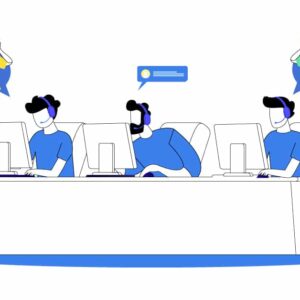
5-Point Likert Scale
Is 5-Point Likert Scale a Better Choice to use? SHARE THE ARTICLE ON Table of Contents Before learning more about the Likert scale, let us

Find the best survey software for you!
(Along with a checklist to compare platforms)
Take a peek at our powerful survey features to design surveys that scale discoveries.
Explore Voxco
Need to map Voxco’s features & offerings? We can help!
Find the best customer experience platform
Uncover customer pain points, analyze feedback and run successful CX programs with the best CX platform for your team.

We’ve been avid users of the Voxco platform now for over 20 years. It gives us the flexibility to routinely enhance our survey toolkit and provides our clients with a more robust dataset and story to tell their clients.
Steve Male
VP Innovation & Strategic Partnerships, The Logit Group
Explore Regional Offices

Find the best survey software for you!
(Along with a checklist to compare platforms)
Take a peek at our powerful survey features to design surveys that scale discoveries.
Explore Voxco
Need to map Voxco’s features & offerings? We can help!
Find the best customer experience platform
Uncover customer pain points, analyze feedback and run successful CX programs with the best CX platform for your team.

We’ve been avid users of the Voxco platform now for over 20 years. It gives us the flexibility to routinely enhance our survey toolkit and provides our clients with a more robust dataset and story to tell their clients.
Steve Male
VP Innovation & Strategic Partnerships, The Logit Group
Explore Regional Offices

Find the best survey software for you!
(Along with a checklist to compare platforms)
Take a peek at our powerful survey features to design surveys that scale discoveries.
Explore Voxco
Need to map Voxco’s features & offerings? We can help!
Find the best customer experience platform
Uncover customer pain points, analyze feedback and run successful CX programs with the best CX platform for your team.

We’ve been avid users of the Voxco platform now for over 20 years. It gives us the flexibility to routinely enhance our survey toolkit and provides our clients with a more robust dataset and story to tell their clients.
Steve Male
VP Innovation & Strategic Partnerships, The Logit Group
Explore Regional Offices
SHARE THE ARTICLE ON

Understanding customers, their preferences, behaviors, and needs is at the core of a successful business strategy. Two primary types of data play a crucial role in this domain: operational data and survey data. When combined, the value of customer insights derived from these data sources amplifies significantly. Let’s delve in.
Operational data refers to the information generated through the regular operations of a business. This includes transactional records, sales figures, website interactions, and other data points that reflect the day-to-day functioning of an organization.
Survey data refers to data that is collected explicitly from customers or target audiences through various means such as feedback forms, satisfaction surveys, and questionnaires. It directly captures opinions, preferences, and sentiments.
The convergence of operational and survey data involves meticulously combining these two data sets to gain a more comprehensive understanding of customer behavior and preferences. This synthesis creates a more holistic view, enriching the insights derived from each dataset individually.
When combining these data types, there are several methodologies and approaches to consider. Here are five effective ways to combine operational and survey data:
This approach involves identifying and correlating common data points shared between operational records and survey responses. For instance, it could include matching customer IDs, purchase history, transactional details, or other relevant information present in both data sets. By establishing connections between these shared data points, businesses can discern correlations, trends, or dependencies that provide insights into customer behaviors and preferences.
Utilizing unique identifiers assigned to customers across operational and survey data sets enables the seamless linking of information. Customer IDs act as keys that connect survey responses with specific operational data tied to individual customers. This integration allows for a more comprehensive understanding of a customer’s journey by associating feedback or survey responses directly with their interactions, transactions, or behaviors captured in the operational data.
Temporal alignment involves synchronizing time-stamped data from operational sources with the timing of survey responses. By aligning the timestamps, businesses can examine patterns, trends, or relationships between events captured in the operational data and customers’ feedback obtained through surveys. This alignment helps in understanding how certain operational activities or changes might influence customer sentiments or behaviors over time.
Segmenting customers based on shared characteristics derived from both operational and survey data allows for more targeted insights. By grouping customers into segments or cohorts based on demographics, purchase behaviors, preferences, or survey responses, businesses can gain a deeper understanding of distinct customer groups. This analysis aids in tailoring strategies and experiences that cater specifically to the needs and preferences of these segments.
Leveraging machine learning models involves using algorithms and predictive analytics to extract insights from the combined data sets. These models can forecast customer behaviors, preferences, or future interactions by analyzing historical patterns present in both operational and survey data. By employing advanced algorithms, businesses can predict trends, anticipate customer needs, personalize offerings, and optimize strategies to enhance customer experiences.
The combination of operational and survey data offers numerous advantages in enhancing the understanding of customers and their interactions with a business. Here are three key benefits:
1. Comprehensive Customer Insights: By merging these data sets, businesses gain a more holistic view of customers, understanding not only their transactions but also their sentiments and preferences.
2. Refined Personalization and Targeting: The combined data empowers businesses to tailor their strategies more accurately, offering personalized experiences and targeted marketing campaigns.
3. Informed Decision-Making: The enriched insights derived from merged data sets assist in making informed, data-driven decisions, optimizing operations, and improving customer satisfaction.
In the pursuit of understanding customer behavior and preferences, merging operational and survey data stands as an extremely valuable approach. As we’ve glimpsed in this blog, the combination of these data types holds immense potential for businesses seeking comprehensive insights.

Is 5-Point Likert Scale a Better Choice to use? SHARE THE ARTICLE ON Table of Contents Before learning more about the Likert scale, let us

Dive into Quantitative Observation’s Rich Insights: Definition, Types and Examples SHARE THE ARTICLE ON Table of Contents With rapidly evolving digitalization and connectivity, we are

How Understanding Unhappy Members Makes Healthcare Better for Everyone Try a free Voxco Online sample survey! Unlock your Sample Survey LISTEN TO THE ARTICLE Voxco

Customer Service Metrics See what question types are possible with a sample survey! Try a Sample Survey Table of Contents 01 What are Customer Service

A Comprehensive Guide to Correlation Coefficient Analysis SHARE THE ARTICLE ON Table of Contents The correlation coefficient is a statistical analysis method that is used

Occasion Segmentation: Unlocking Purchase Moments Download our Market Segmentation Guide to understand how to deliver a best in class experience by understanding customer needs. Download
We use cookies in our website to give you the best browsing experience and to tailor advertising. By continuing to use our website, you give us consent to the use of cookies. Read More
| Name | Domain | Purpose | Expiry | Type |
|---|---|---|---|---|
| hubspotutk | www.voxco.com | HubSpot functional cookie. | 1 year | HTTP |
| lhc_dir_locale | amplifyreach.com | --- | 52 years | --- |
| lhc_dirclass | amplifyreach.com | --- | 52 years | --- |
| Name | Domain | Purpose | Expiry | Type |
|---|---|---|---|---|
| _fbp | www.voxco.com | Facebook Pixel advertising first-party cookie | 3 months | HTTP |
| __hstc | www.voxco.com | Hubspot marketing platform cookie. | 1 year | HTTP |
| __hssrc | www.voxco.com | Hubspot marketing platform cookie. | 52 years | HTTP |
| __hssc | www.voxco.com | Hubspot marketing platform cookie. | Session | HTTP |
| Name | Domain | Purpose | Expiry | Type |
|---|---|---|---|---|
| _gid | www.voxco.com | Google Universal Analytics short-time unique user tracking identifier. | 1 days | HTTP |
| MUID | bing.com | Microsoft User Identifier tracking cookie used by Bing Ads. | 1 year | HTTP |
| MR | bat.bing.com | Microsoft User Identifier tracking cookie used by Bing Ads. | 7 days | HTTP |
| IDE | doubleclick.net | Google advertising cookie used for user tracking and ad targeting purposes. | 2 years | HTTP |
| _vwo_uuid_v2 | www.voxco.com | Generic Visual Website Optimizer (VWO) user tracking cookie. | 1 year | HTTP |
| _vis_opt_s | www.voxco.com | Generic Visual Website Optimizer (VWO) user tracking cookie that detects if the user is new or returning to a particular campaign. | 3 months | HTTP |
| _vis_opt_test_cookie | www.voxco.com | A session (temporary) cookie used by Generic Visual Website Optimizer (VWO) to detect if the cookies are enabled on the browser of the user or not. | 52 years | HTTP |
| _ga | www.voxco.com | Google Universal Analytics long-time unique user tracking identifier. | 2 years | HTTP |
| _uetsid | www.voxco.com | Microsoft Bing Ads Universal Event Tracking (UET) tracking cookie. | 1 days | HTTP |
| vuid | vimeo.com | Vimeo tracking cookie | 2 years | HTTP |
| Name | Domain | Purpose | Expiry | Type |
|---|---|---|---|---|
| __cf_bm | hubspot.com | Generic CloudFlare functional cookie. | Session | HTTP |
| Name | Domain | Purpose | Expiry | Type |
|---|---|---|---|---|
| _gcl_au | www.voxco.com | --- | 3 months | --- |
| _gat_gtag_UA_3262734_1 | www.voxco.com | --- | Session | --- |
| _clck | www.voxco.com | --- | 1 year | --- |
| _ga_HNFQQ528PZ | www.voxco.com | --- | 2 years | --- |
| _clsk | www.voxco.com | --- | 1 days | --- |
| visitor_id18452 | pardot.com | --- | 10 years | --- |
| visitor_id18452-hash | pardot.com | --- | 10 years | --- |
| lpv18452 | pi.pardot.com | --- | Session | --- |
| lhc_per | www.voxco.com | --- | 6 months | --- |
| _uetvid | www.voxco.com | --- | 1 year | --- |